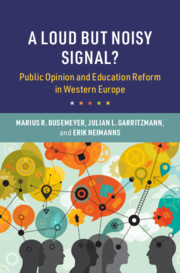Book contents
- A Loud but Noisy Signal?
- Cambridge Studies in the Comparative Politics of Education
- A Loud but Noisy Signal?
- Copyright page
- Contents
- Figures
- Tables
- Preface and Acknowledgments
- 1 Introduction
- 2 Theoretical Framework
- Part I Quantitative Evidence: Attitudes, Public Opinion, and Politics
- Part II Qualitative Evidence: The Role of Public Opinion in Education Reforms in Western Europe
- 9 Comparative Summary and Conclusions
- References
- Index
2 - Theoretical Framework
Published online by Cambridge University Press: 14 September 2020
- A Loud but Noisy Signal?
- Cambridge Studies in the Comparative Politics of Education
- A Loud but Noisy Signal?
- Copyright page
- Contents
- Figures
- Tables
- Preface and Acknowledgments
- 1 Introduction
- 2 Theoretical Framework
- Part I Quantitative Evidence: Attitudes, Public Opinion, and Politics
- Part II Qualitative Evidence: The Role of Public Opinion in Education Reforms in Western Europe
- 9 Comparative Summary and Conclusions
- References
- Index
Summary
This theoretical chapter introduces in greater detail the conceptual framework of the book. In the first part of this chapter, we revisit and review existing scholarship on public attitudes and preferences. The second half focuses on how public preferences are transferred into policy-making. We argue that the influence of public opinion on policy-making is strongest in the world of “loud politics,” when the salience of an issue is high and attitudes are coherent. In contrast, interest groups have a strong influence on policy-making in the realm of “quiet politics,” when salience is low. Third, when salience is high, but popular attitudes are conflicting, the dynamics of policy-making are likely to follow a pattern of partisan politics (“loud but noisy politics”). We posit that education is a particularly well-suited policy area to demonstrate the usefulness of our framework as salience and coherence of attitudes vary across different educational sectors and policy issues. However, the framework is also applicable to other policy areas.
Keywords
- Type
- Chapter
- Information
- A Loud but Noisy Signal?Public Opinion and Education Reform in Western Europe, pp. 17 - 52Publisher: Cambridge University PressPrint publication year: 2020



